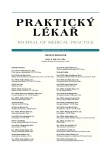Základy kognitivní, afektivní a sociální neurovědy
VI. Volní rozhodování
Authors:
F. Koukolík
Authors‘ workplace:
Primář: MUDr. František Koukolík, DrSc.
; Oddělení patologie a molekulární medicíny
; Národní referenční laboratoř prionových chorob
; Fakultní Thomayerova nemocnice s poliklinikou, Praha
Published in:
Prakt. Lék. 2011; 91(6): 315-320
Category:
Editorial
Overview
Results of neurobiological experiments with animals and humans have become part of the discourse about free will in the new millenium. There are two neuronal circuits of volition in human brain:
– ventral (whose nodes are basal ganglia – prefrontal cortex – presupplemental motor area – supplementary motor area – primary motor cortex), and
– dorsal (whose nodes are sensory cortices – parietal cortex – lateral promotor cortex – primary motor cortex).
The anterior insular cortex is a newly discovered node. Phases of volition are
– the early whether decision,
– what decisions (goal selection and movement selection) , and
– the late whether decision (final predictive check and veto);
– when decision.
Damage of those nodes / phases is recognised in a number of common ailments.
Unconscious mechanisms widely influence free will. Free will is an adaptive biological trait. The scientific concept of free will is a quantitative not qualitative concept. The right question is probably “how much free will do have we?”, not “do we have free will or not?”
Key words:
free will, neuronal circuits, unconscious mechanisms, adaptive trait.
Sources
1. Akkal, D., Dum, R.P., Strick, P.L. Supplementary motor area and presupplementary motor area: targets of basal ganglia and cerebellar output. J. Neurosci. 2007, 27, p. 10659-10673.
2. Banks, P.W., Isham, E.A. We infer rather than perceive the moment we decided to act. Psychol. Sci. 2009, 20, p. 17-21.
3. Brass, M., Haggard, P. To do or not to do: the neural signature of self control. J. Neurosci. 2007, 27, p. 9141-9145.
4. Brass, M., Haggard, P. The hidden side of intentional action: the role of the anterior insular cortex. Brain Struct. Funct. 2010, 214, p. 603-610.
5. Brembs, B. The importance of being active. J. Neurogenet. 2008, 23, p. 120-126.
6. Brembs, B. Toward scientific concept of free will as a biological trait: spontaneous actions and decision-making in invertebrates. Proc. R. Soc. B. 2011, 278, p. 930-939.
7. Custers, R., Aarts, H. The unconscious will: how the pursuit of goals operates outside of conscious awareness. Science 2010, 329, p. 47-50.
8. Dobzhansky, T. Nothing in biology makes sense except in the light of evolution. Am. Biol. Teach. 1973, 35, p. 125-129. Dostupné též na http://people.delphiforums.com/lordorman/light.htm.
9. Dennett, D. Consciousness explained. London: The Penguin Press, 1991.
10. Dennett, D., Kinsbourne, M. Time and the observer. Behav. Brain Sci. 1992, 15, p. 183-274.
11. Domenici, P., Booth, D., Blagburn, J.M. et al. Cockroaches keep predators guessing by using preferred escapes trajectories. Curr. Biol. 2008, 18, p. 1792-1796.
12. Doyle, R.O. Free will: it´s normal biological trait, not a gift or a mystery. Nature 2009, 459, p. 1052.
13. Doyle, B. Jamesian free will. The two stage-model of William James. William James Studies 2010, 5, p. 1-28.
14. Wikipedia. Free will [on-line]. Dostupné na http://en.wikipedia.org/wiki/Free_will.
15. Friesen, W.O., Kristan, W.B. Leech locomotion: swimming, crawling, and decision. Curr. Opin. Neurobiol. 2007, 17, p. 704 – 711.
16. Haggard, P., Eimer, M. On the relation between brain potentials and the awareness of voluntary movement. Exp. Brain Res. 1999, 126, p. 128-133.
17. Haggard, P. Human volition: towards a neuroscience of will. Nature Reviews Neuroscience 2008, 9, p. 934-946.
18. Hallettt, M. Volitional control of movement: the fysiology of free will. Clin. Neurophysiol. 2007, 118, p. 1179-1192.
19. Heisenberg, M. Is free will an illusion? Nature 2009; 459, p. 164-165.
20. Hume, D. A treatise on human nature (1739) [on-line]. Dostupné na http://oll.libertyfund. org/index.php?option=com_staticxt&staticfile=show.php%3Ftitle=342&Itemid=28.
21. Koukolík, F. Funkční systémy lidského mozku. Galén, Praha 2011(v tisku)
22. Kristan, W.B. Neuronal desicion-making circuits. Curr. Biol. 2008, 18, R929-R932.
23. Kühn, S., Brass, M. Retrospective construction of the judgement of free choice. Conscious. Cogn. 2009, 18, p. 12-21.
24. Libet, B., Gleason, C.A., Wright, W. et al. Time of conscious intention to act in relation to onset of cerebral activity (readiness-potential). The unconscious initiation of freely voluntary act. Brain 1983, 106, p. 623-642.
25. London, M., Roth, A., Beeren, L. et al. Sensitivity to perturbation in vivo implies high noise and suggest rate coding in cortex. Nature 2010, 466, p. 123-127.
26. Nachev, P., Rees, G., Parton, A. et al. Volition and conflict in human medial frontal cortex. Curr. Biol. 2005, 15, p. 122-128.
27. Pessiglione, M., Schmidt, L., Draganski, B. et al. How the brain translates money into force: a neuroimaging study of subliminal motivation. Science 2007, 316, p. 904-906.
28. Searle, J. Minds, brains, and science. Cambridge, MA: Harvard University Press, 1984.
29. Shibasaki, H., Hallett, M. What is the Bereitschaftspotential? Clin. Neurophysiol. 2006, 117, p. 2341-2356.
30. Soon, Ch. S., Brass, M., Heinze, H-J. et al. Unconscious determinants of free decisions in the human brain. Nat. Neurosci. 2008, 11, p. 543-545.
31. Wegner, D.M., Wheatley, T. Apparent mental causation. Sources of the experience of will. Am. Psychol. 1999, 54, p. 480-492.
32.Wegner, D.M. The illusion of conscious will. Cambridge, MA: MIT Press, 2003.
Labels
General practitioner for children and adolescents General practitioner for adultsArticle was published in
General Practitioner

2011 Issue 6
Most read in this issue
- History and present status of surgical treatment of lung tuberculosis
- Inflammatory back pain – when should be a spondylarthritis considered?
- Vasovagal syncope
- The problem of nutrition in oncology patients
